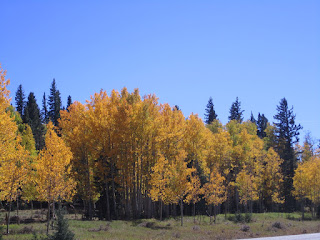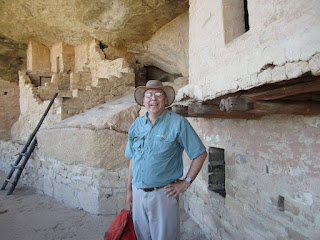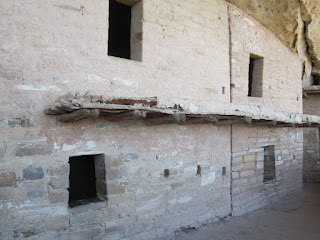Mesa Verde has been described by Gustaf Nordenskiold, the first archaeologist to explore and document the cliff dwellings at Mesa Verde, as "America's Rome, America's Athens". When you think that the Pilgrims came here in 1620 and we declared our independence from Great Britain in 1776, we are such a young country. But of course, the Native American peoples were here long before the Europeans arrived.
Mesa Verde is sacred ground to these peoples.....29 different tribes in the Colorado, Utah, and New Mexico area. A beautiful place to visit and experience.
We arrived just as the near-full moon was rising.....seems to be what we do, doesn't it? Checked in and went to a wonderful dinner at the restaurant at the lodge. Again, heading back to our room, I looked up and saw a shooting star! Amazing!
We only had a day to explore so decided to take several tours of the Cliff Palace, the Balcony House and another twilight tour of the Cliff Palace. At the twilight tour, one of the park rangers role-plays a historical character from the late 1880's and gives the tour from that perspective.
It was a beautiful, blue sky day and not too warm. My daughter, Megan, had suggested we do both tours even though there were many ladders to climb.....one being 30 feet tall! Remember these are CLIFF dwellings and you get the picture of how scary the ladder climb is!
People lived on the mesa top for many, many years until moving to the cliff houses around 1190 AD. They resided there until 1270 AD, when they seemed to totally vanish off the face of the earth. There are many theories as to what made them move to the cliffs in the first place, and what eventually caused them to move away. No one really knows for sure. If you should ask the native peoples today why they left Mesa Verde, you will get the same answer from all: "It was time to move on". A cryptic answer indeed.
Here are a few pictures of the Cliff Palace from the morning tour:
|
|
|
|
 |
| Inside the tower |
|
|
The ladders here weren't too bad. There were 3 eight-foot ladders heading out as well as some stone steps. Imagine the surprise as we headed up the stone steps on our way out and met up with our little friend!
 |
| Luckily, it was a BABY tarantula!!! |
The Balcony House proved a bit more challenging....here the initial climb was up a double 30 foot ladder. The ranger gave us good advice when he said to look only at the two rungs in front of you. At one point, I peeked through to the rock wall beneath me, and it nearly did me in! I quickly looked at the two rungs just in front of me, and was able to make it to the top. I found out later that Mike nearly froze until he started singing in his head (more advice from the ranger). |
|
|
|
There was a section up here that was built during two different periods as shown by the wooden beams on the side of the dwelling. On the left they were two by two, and on the right they are single beams.
We had a few more ladders to climb, and then had to crawl through a tunnel, and then we were on our way. They believe the tunnel to be a strictly defensive one, which begs an answer to the question, "Who or what did they feel the need to be defensive of??"
|
|
|
|
|
 |
| Mike climbing out of the tunnel |
|
We had a few hours to explore on our own before heading back for the twilight tour. We did the Mesa Loop road and saw many sites from different time periods, many kivas, and loved the Spruce Tree House. There we actually could climb down a ladder into a kiva to see what they were like.
After a quick bite to eat, we headed back to the Cliff Palace for our evening tour. Our guide, Josh Pelham, was actually the same one from the Balcony tour, only now he was Gustav Nordenskiold, the archaeologist from 1891. He gave an awesome, yet disturbing accounting of what he discovered as he explored these cliff dwellings for a six-month period from June 1891 until December 1891.
He spoke of finding many, many tools, especially hammers. He spoke of finding food in pottery jars....left out as if someone would be returning shortly. He spoke of finding 100 skeletons and discovering a burned human bone. His curiosity had been piqued when he was at a museum in Denver that showed a human skeleton in the fetal position. When he asked where it had come from, he was told from Mesa Verde, which led him there. There he met up with the Weatherill brothers who had discovered Cliff Palace in 1888.
He was so very interesting, and people were mesmerized by what he told us. He spoke of the Spanish who came looking for one of the cities of gold, and he wondered if perhaps they had found it here. When you see these sunset pictures of the Cliff Palace, it does, indeed, resemble a city of gold:
|
 |
| A city of gold? |
|
We came away from this tour quietly thinking about all we had been told, and wondering just what had really happened here.
~Karen
From Mike:
Josh, the ranger, "returned" at the end of the tour and made it clear that what we know of history is only stories seen through the eyes of those who tell them. Gustaf had made many correct assumptions, but some false ones too. There was no evidence of great violence at Mesa Verde, although there was evidence of stress and depleting resources, and indications that the people moved south, burning their
Kiva's as they left. Because of the
NAGPRA (Native American Graves and Repatriation Act) passed in 1990 it is against the law to study the bones more than just visually. They can't legally do any of the new DNA tests or other tests to find out more of what happened. They "will not touch" Gustaf's claim about the human bone. Perhaps fire, perhaps burial (although evidence points that the Anasazi did not believe in cremation). The historians now rely mainly on Hopi and other Pueblo tribal accounts and archaeological evidence.
I also found Mesa Verde a fascinating and very sacred space. I was impressed by the respect given to it by the Park Rangers and all who were visiting.
--Mike























































